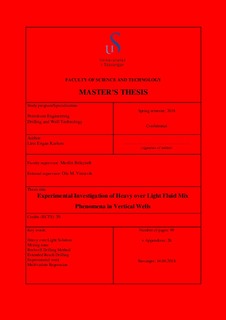| dc.contributor.advisor | Belayneh, Mesfin | |
| dc.contributor.advisor | Vestavik, Ola M. | |
| dc.contributor.author | Karlsen, Linn Engan | |
| dc.date.accessioned | 2018-10-18T09:20:45Z | |
| dc.date.available | 2018-10-18T09:20:45Z | |
| dc.date.issued | 2018-05 | |
| dc.identifier.uri | http://hdl.handle.net/11250/2568596 | |
| dc.description | Master's thesis in Petroleum engineering | nb_NO |
| dc.description.abstract | The Heavy over Light (HOL) solution, invented by Reelwell, is a main feature of the Reelwell Drilling Method (RDM) and has the potential to improve the capability to drill through challenging pressure zones. This solution can reduce torque and drag and enable Managed Gradient Drilling (MGD) operations to be performed with little to no wellhead pressure. MGD is an advanced version of Managed Pressure Drilling (MPD) and can provide a constant downhole pressure gradient.
The RDM solution is comprised of using a dual drill string for improved downhole pressure measurement and control. This solution utilizes a passive heavy fluid in the well annulus and an active light fluid for cleaning the well. The MGD performance depends the ability to control the mixing zone between these two fluids during the operations.
The HOL solution in the horizontal sections was verified by Reelwell in a test well in Canada
in 2016, but the vertical section still remains to be investigated and verified.
This thesis presents a thorough investigation of the HOL mixing zone in the vertical section of experimental wells. Experiments with different fluid properties and various well diameters has been conducted and the relation between these parameters and the mixing zone length is presented.
The experimental result showed that both the clearance between the well and the drill string and the lower shear yield stress (LSYS) of the light fluid have effects on the mixing zone length.
This is also confirmed by theory. Critical values for Δρ, ΔPV and for the viscoelastic ratio, (𝐻�𝐺�′ − 𝐿�𝐺�′)⁄(𝐻�𝐺�′′ − 𝐿�𝐺�′′), where the mixing zone is short and stable below these values, have been observed. In addition, the mixing zone as a function of a correlation factor is presented and multivariate regression models have been developed. Finally, it is shown good comparison between the models and the experimental data. For further work, it would be preferable to perform a greater amount of experiments with larger well diameters and longer well pipes. | nb_NO |
| dc.language.iso | eng | nb_NO |
| dc.publisher | University of Stavanger, Norway | nb_NO |
| dc.relation.ispartofseries | Masteroppgave/UIS-TN-IEP/2018; | |
| dc.subject | petroleumsteknologi | nb_NO |
| dc.subject | petroleum engineering | nb_NO |
| dc.subject | heavy over light solution | nb_NO |
| dc.subject | mixing zone | nb_NO |
| dc.subject | reelwell drilling method | nb_NO |
| dc.subject | extended reach drilling | nb_NO |
| dc.subject | experimental work | nb_NO |
| dc.subject | multivariate regression | nb_NO |
| dc.title | Experimental Investigation of Heavy over Light Fluid Mix Phenomena in Vertical Wells | nb_NO |
| dc.type | Master thesis | nb_NO |
| dc.subject.nsi | VDP::Teknologi: 500::Berg‑ og petroleumsfag: 510::Petroleumsteknologi: 512 | nb_NO |
